

The Fall of Rome Explained In 13 Minutes. Untitled. Rome Reborn 2.2: A Tour of Ancient Rome in 320 CE. The Roman Forum. Untitled. The Roman Empire was in essence an urban empire.
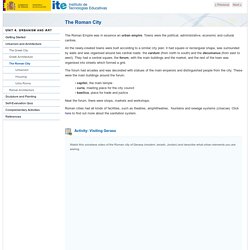
Towns were the political, administrative, economic and cultural centres. All the newly-created towns were built according to a similar city plan: it had square or rectangular shape, was surrounded by walls and was organised around two central roads: the cardum (from north to south) and the decumanus (from east to west). They had a central square, the forum, with the main buildings and the market, and the rest of the town was organised into streets which formed a grid.
The forum had arcades and was decorated with statues of the main emperors and distinguished people from the city. These were the main buildings around the forum: - capitol, the main temple - curia, meeting place for the city council - basilica, place for trade and justice Near the forum, there were shops, markets and workshops.
Roman cities had all kinds of facilities, such as theatres, amphitheatres, fountains and sewage systems (cloacae). Untitled. Untitled. A Day In The Life... Of A 10-Year-Old In Roman Britain - Hands On History - BBC. A glimpse of teenage life in ancient Rome - Ray Laurence. ROMULUS AND REMUS. Romulus & Remus, The Story of. ROMA EN 3D. La Roma Imperial 05 de 16 serie: Grandes Civilizaciones / Exploradores de la Historia. La Domus Romana - Gran Enciclopedia Aragonesa. La Eduteca - Los números romanos. ANTIGUA ROMA (HISTORIAE) TARQUINIO, ÚLTIMO REY DE ROMA.
La historia tradicional de los orígenes de Roma gira en torno a una fecha crucial: el año 509 a.C., en que fue derrocado el último de los siete reyes que gobernaron la ciudad desde la época de Rómulo, dos siglos y medio atrás, para dar paso a la República.

Ese último rey de Roma se llamaba Tarquinio, pero la tradición histórica romana le dio el apodo de «el Soberbio», diferenciándolo así de otro Tarquinio que había reinado en Roma unas décadas antes, Tarquinio Prisco. En efecto, en la memoria histórica de la Roma republicana Tarquinio el Soberbio encarnó los peores vicios de la monarquía y fue visto como un modelo de tirano y enemigo de la patria. Para saber más Entrevista a Virgilio Ortega: Autor de "Palabrotalogia" "¿Quién amamantó a Rómulo y Remo? Virgilo Ortega explora el significado de las palabras actuales y se remonta miles de años atrás, aunque advierte que "toda investigación etimológica conduce a un fracaso" Leer artículo El crimen original Historia Un rey guerrero Para saber más.
Planets. All of the planets, except for Earth, were named after Roman gods and goddesses.

Jupiter, Saturn, Mars, Venus and Mercury were given their names thousands of years ago. Those were the planets that the ancient Romans could see in the sky without a telescope. The other planets in our solar system were not discovered until much later, when telescopes were invented. Amazing! Hannibal's Elephants of War - Explore - BBC. Causas de la caída del imperio romano. Crisis of the Third Century of the Roman Empire DOCUMENTARY. Ten Minute History - The Fall of Rome (Short Documentary) Ancient Roman Homes - Domus, Insulae, Villa.
Ancient Roman Homes Domus In ancient Rome, the domus was the type of house occupied by the upper classes and some wealthy freedmen during the Republican and Imperial eras.
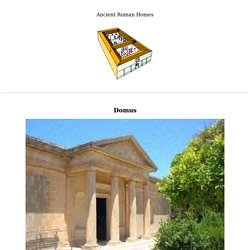
It comes from the Ancient Greek word domi meaning structure since it was the standard type of housing in Ancient Greece. It could be found in almost all the major cities throughout the Roman territories. The modern English word domestic comes from Latin domesticus, which is derived from the word domus. The word dom in modern Slavic languages means "home" and is a cognate of the Latin word, going back to Proto-Indo-European.
The elite classes of Roman society constructed their residences with elaborate marble decorations, inlaid marble paneling, door jambs and columns as well as expensive paintings and frescoes. La ciudad romana. Grandes Civilizaciones : Roma. Ancient Rome for Kids. Educational Video for Kids. Julius Caesar Biography. El Imperio Romano en 10 minutos (remasterizado)
Arquitectura romana. La casa romana - The Roman houses. Barbarians Rising: Rise and Fall of an Empire. Rutas arqueológicas por Navarra: VILLA DE LAS MUSAS - Arellano. A 6,5 kilómetros al sur de Arellano se encuentra la Villa romana de Las Musas.
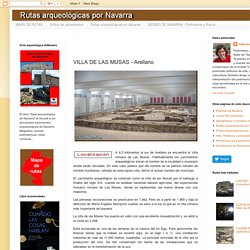
Habitualmente los yacimientos arqueológicos toman el nombre de la localidad o municipio donde están ubicadas. En este caso parece que del nombre de un patricio romano de nombre Aurelianus, retirado en esta lujosa villa, derivó el actual nombre del municipio. El yacimiento arqueológico es conocido como la villa de las Musas por el hallazgo a finales del siglo XIX, cuando se estaban haciendo labores agrícolas, del espectacular mosaico romano de Las Musas, donde se representan las nueve diosas con sus maestros. Las primeras excavaciones se practicaron en 1.942. Pero es a partir de 1.985 y bajo la dirección de María Ángeles Mezquíriz cuando se sacó a la luz la que es la villa romana más importante de Navarra.
La villa de las Musas fue puesta en valor con una excelente musealización y se abrió a la visita en 2.008. Está enclavada en una de las terrazas de la cuenca del río Ega. The Roman Forum. Ancientvine - Virtual Roman House 3D Reconstruction. Roman House 3D. YouTube. Ancient Rome (higher resolution) Ancient Roman Architecture. GH1-Ch10-RomeTimeline. 10a Roman Towns and Architecture. Khanacademy. Historia. · ¡Hola chicos y chicas!
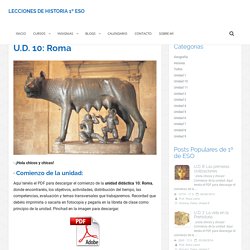
Ancient Rome. Animated History of the Roman Empire 510 BC - 1453 AD. The History of the Romans: Every Year. The Rise and Fall of the Roman Empire. 3 Minutes in the Roman Empire. Ancient Rome - Ancient History. Augustus’ rule restored morale in Rome after a century of discord and corruption and ushered in the famous pax Romana–two full centuries of peace and prosperity.
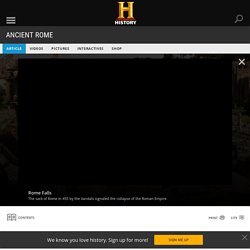
He instituted various social reforms, won numerous military victories and allowed Roman literature, art, architecture and religion to flourish. Augustus ruled for 56 years, supported by his great army and by a growing cult of devotion to the emperor. When he died, the Senate elevated Augustus to the status of a god, beginning a long-running tradition of deification for popular emperors.
Augustus’ dynasty included the unpopular Tiberius (14-37 A.D.), the bloodthirsty and unstable Caligula (37-41) and Claudius (41-54), who was best remembered for his army’s conquest of Britain. History: Ancient Rome for Kids. Back to History for Kids Ancient Rome was a powerful and important civilization that ruled much of Europe for nearly 1000 years.

The culture of Ancient Rome was spread throughout Europe during its rule. As a result, Rome's culture still has an impact in the Western world today. The basis for much of Western culture comes from Ancient Rome, especially in areas such as government, engineering, architecture, language, and literature. Ancient Roman History for Kids - Fun Facts to Learn.